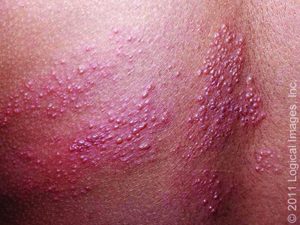There is a painful ailment that affects millions of people: shingles.
What is shingles?
Shingles is a blistering rash that is caused by a virus called herpes zoster. It effects approximately one million people in America every year. The herpes zoster virus, what we call shingles, is actually the same virus as the chicken pox you may have experienced as a child. When patients develop chicken pox, caused by a virus called Varicella-zoster, it lies dormant in your body for the rest of your life. Then, later in life, it may reactivate into another form we call shingles.
The reactivation of the virus that lays dormant in your body is caused by many risk factors. Commonly as you age, especially after the ages of 50-60 years old, your chances of incidence increased dramatically. Although, there are also many patients younger than 50 who also develop shingles. Typically, patients who are immunocompromised, have had a recent cold or are highly stressed in their daily lives, are at increased risk for an incidence of shingles.
What are some signs and symptoms?
Some of the signs and symptoms of shingles include a red rash that quickly evolves into groups of vesicles or blisters. Many patients may experience a burning or tingling sensation prior to onset of the rash that could last days or even weeks before eruption of lesions. Other patients may also experience signs and symptoms of a cold, such as fever, fatigue, chills and headache. The rash can also be very painful for many patients and cause complications that may last even after the rash has resolved.
 Usually, the rash from the shingles is only on one side of the body, and this unilateral distribution is a classic presentation that helps doctors to diagnose patients. The rash can appear on your head, face, neck, torso, arms or legs, but typically, the rash appears on the torso for many patients. After eruption of the rash and blisters, the vesicles may rupture and crust over in about seven to 10 days.
Usually, the rash from the shingles is only on one side of the body, and this unilateral distribution is a classic presentation that helps doctors to diagnose patients. The rash can appear on your head, face, neck, torso, arms or legs, but typically, the rash appears on the torso for many patients. After eruption of the rash and blisters, the vesicles may rupture and crust over in about seven to 10 days.
How’s it treated and prevented?
If you suspect you may have shingles, please see your healthcare provider right away! The prompt and proper diagnosis of the disease is crucial when providing treatment for shingles. If caught early, within 72 hours, doctors can prescribe medications that may help to hasten and help decrease the severity of the virus. These medications can equally help to also prevent complications from shingles, which may include losing your vision and hearing, meningitis and other neurologic complications. Your healthcare provider also can help to give you medications that may help to reduce the pain and burning sensations that can be very debilitating for many patients.
One of the best ways to prevent an outbreak from occurring is for older adults and patients who are at high risk, to receive their shingles vaccine. Although this vaccine does not prevent the disease 100 percent, it will significantly reduce your risk, and if you do have an incidence of shingles, it can help to reduce the severity of the virus.
HOUSE CALL MEDICAL PRACTICE
808-726-5062 | housecallmed@gmail.com
housecallmedhawaii.com


Leave a Reply